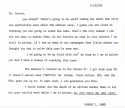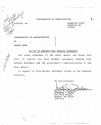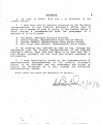eve carson
Verified Family - Joan Webster
- Joined
- Oct 9, 2006
- Messages
- 540
- Reaction score
- 717
The Ralph Anthony Pisa “Story”
On December 24, 1979, Pisa had a holiday furlough courtesy of Gov. Michael Dukakis. A convicted killer once on death row was allowed to leave his confinement to celebrate the holiday with family and friends. On Christmas Eve 1979, Pisa was at the home of attorney John Cavicchi, the lawyer he did work for. While he was there, Paradiso brought a bucket of fish to the attorney, a gift.
Paradiso had paid Cavicchi a $500 retainer to arrange a polygraph. The examination performed by William La Parl on August 28, 1979, indicated Paradiso was telling the truth; he did not murder Marie Iannuzzi. The check and polygraph report are in recovered documents.
Pisa claimed Paradiso asked him to step out on the porch at Cavicchi's home on December 24, 1979. Pisa alleged Paradiso confessed murdering Marie and wanted Pisa’s influence to get Cavicchi to represent him. There is no corroborating evidence to support Pisa’s claim. It is illogical on the surface based on known facts. Pisa said nothing about the alleged conversation at the time.
Pisa came forward after Bond allegations broke in the paper in January 1983. Paradiso was all over the news and Pisa remembered him from Norfolk.
When Pisa spoke first to Middlesex County, and then to Suffolk County, his story expanded. Pisa later testified under oath that Paradiso called him on December 18, 1981. Pisa was specific about the date; it was his birthday. Pisa was still in prison, so any calls were taken on a bank of phones. It is unclear if conversations were monitored. No evidence of the call was provided. Pisa came forward more than a year later, so any taped calls may have already been erased or taped over.
Pisa claimed Paradiso warned him to keep his mouth shut; Pisa had a family out there. Allegedly, Paradiso asked about charges if there was no body. Pisa claimed Paradiso said they only found the purse. That information was all over the news along with the Bond allegations about Joan.
According to the state’s interpretation, Paradiso confessed to murdering Joan. This was solely based on Pisa’s word with no verification. Burke touted Pisa as credible and a reformed prisoner with altruistic motives, to protect the women of Boston.
Pisa became self-educated on the law while in prison. During his testimony, he claimed Paradiso wanted to know if someone could be convicted without a body. Pisa allegedly referred to the John Webster case of 1850. This case is still cited today as a standard; the jury must determine guilt beyond a reasonable doubt.
As I read through the records, the reference to the John Webster case was almost a subliminal message that kept the name Webster in front of the Iannuzzi jury.
A brief tutorial on the John Webster case. Dr. George Parkman went missing. Webster, a Harvard professor borrowed money from Parkman. The case received a lot of media attention. There was speculation Parkman was dumped in the ocean. A Harvard janitor Ephraim Littlefield found disturbing evidence in Webster’s lab. Webster had hit Parkman in the head and put dismembered pieces in the furnace. Parkman’s dental work was identified by the dentist who did the work, but there was no body. Littlefield was under suspicion for a while, but Webster was ultimately found guilty. Webster confessed in a last ditch effort to save his own neck, but Webster was hanged.
There was nothing concrete or verifiable to support Pisa’s allegations. Most people would be skeptical of a convicted murderer’s unsubstantiated story. The key point to focus on why people bought into it is evident in the records. The people we are conditioned to trust, prosecutors and law enforcement, reinforced it.
That is the question to answer. Why did authorities promote obvious confabulations? To top that off, they greased the wheels to let Pisa walk.
On December 24, 1979, Pisa had a holiday furlough courtesy of Gov. Michael Dukakis. A convicted killer once on death row was allowed to leave his confinement to celebrate the holiday with family and friends. On Christmas Eve 1979, Pisa was at the home of attorney John Cavicchi, the lawyer he did work for. While he was there, Paradiso brought a bucket of fish to the attorney, a gift.
Paradiso had paid Cavicchi a $500 retainer to arrange a polygraph. The examination performed by William La Parl on August 28, 1979, indicated Paradiso was telling the truth; he did not murder Marie Iannuzzi. The check and polygraph report are in recovered documents.
Pisa claimed Paradiso asked him to step out on the porch at Cavicchi's home on December 24, 1979. Pisa alleged Paradiso confessed murdering Marie and wanted Pisa’s influence to get Cavicchi to represent him. There is no corroborating evidence to support Pisa’s claim. It is illogical on the surface based on known facts. Pisa said nothing about the alleged conversation at the time.
Pisa came forward after Bond allegations broke in the paper in January 1983. Paradiso was all over the news and Pisa remembered him from Norfolk.
When Pisa spoke first to Middlesex County, and then to Suffolk County, his story expanded. Pisa later testified under oath that Paradiso called him on December 18, 1981. Pisa was specific about the date; it was his birthday. Pisa was still in prison, so any calls were taken on a bank of phones. It is unclear if conversations were monitored. No evidence of the call was provided. Pisa came forward more than a year later, so any taped calls may have already been erased or taped over.
Pisa claimed Paradiso warned him to keep his mouth shut; Pisa had a family out there. Allegedly, Paradiso asked about charges if there was no body. Pisa claimed Paradiso said they only found the purse. That information was all over the news along with the Bond allegations about Joan.
According to the state’s interpretation, Paradiso confessed to murdering Joan. This was solely based on Pisa’s word with no verification. Burke touted Pisa as credible and a reformed prisoner with altruistic motives, to protect the women of Boston.
Pisa became self-educated on the law while in prison. During his testimony, he claimed Paradiso wanted to know if someone could be convicted without a body. Pisa allegedly referred to the John Webster case of 1850. This case is still cited today as a standard; the jury must determine guilt beyond a reasonable doubt.
As I read through the records, the reference to the John Webster case was almost a subliminal message that kept the name Webster in front of the Iannuzzi jury.
A brief tutorial on the John Webster case. Dr. George Parkman went missing. Webster, a Harvard professor borrowed money from Parkman. The case received a lot of media attention. There was speculation Parkman was dumped in the ocean. A Harvard janitor Ephraim Littlefield found disturbing evidence in Webster’s lab. Webster had hit Parkman in the head and put dismembered pieces in the furnace. Parkman’s dental work was identified by the dentist who did the work, but there was no body. Littlefield was under suspicion for a while, but Webster was ultimately found guilty. Webster confessed in a last ditch effort to save his own neck, but Webster was hanged.
There was nothing concrete or verifiable to support Pisa’s allegations. Most people would be skeptical of a convicted murderer’s unsubstantiated story. The key point to focus on why people bought into it is evident in the records. The people we are conditioned to trust, prosecutors and law enforcement, reinforced it.
That is the question to answer. Why did authorities promote obvious confabulations? To top that off, they greased the wheels to let Pisa walk.











